-
News & Trends -
Sales -
Marketing Related Topics -
B2B Software Guides Related Topics -
Free Tools & Resources -
- About Us About Us


A business proposal is a document that outlines the terms of a deal, including the price, scope of work, and more. It's typically sent to prospects after you've discovered their needs and you want to start the closing process. It can serve as a contract by adding a signature field, or you can send a separate contract with or after discussing the proposal. To write an effective proposal, most salespeople start with a template and customize the required sections for the specific deal terms.
Business proposals tend to be several pages long and include the key sections that will help your prospect understand your offer and how it will solve their pain points. You can also choose to send your proposal with a letter to introduce and summarize it. Quality business proposals follow a standard format that includes the following elements:
Lists your business name and/or logo and communicates to the recipient that the proposal is specifically for them.
Gives the prospect a preview of the proposal and tells them where they'll find certain information.
Lays out an overview of your proposal, including an explanation of your business and why you're sending the proposal.
Details the pain point you've discussed with your prospect and why they shouldn't leave it unresolved.
Explains how your business will solve their problem using your product or service, including the specific type or level you're offering.
Argues why your prospect should choose you over your competitors through credentials and social proof.
Tells the prospect when your project will reach certain milestones or deliverables.
Breaks down each of the costs involved in the proposal so your prospect can see what they'd pay for and why.
Outlines the rules and legal details of the proposal; this can serve as a preview of the contract, or the proposal can double as a contract.
Asks your prospect to move forward with the deal by taking a certain action.
To help you write your own proposal, we created a free template for you following the above format, which we break down in our business proposal template article. To receive the template, simply click the button below and customize the key sections for your business and prospect. We'll incorporate the template into the steps below.
Regardless of your specific business type or client, there is an effective process to follow when writing your business proposal. It includes the following eight steps:
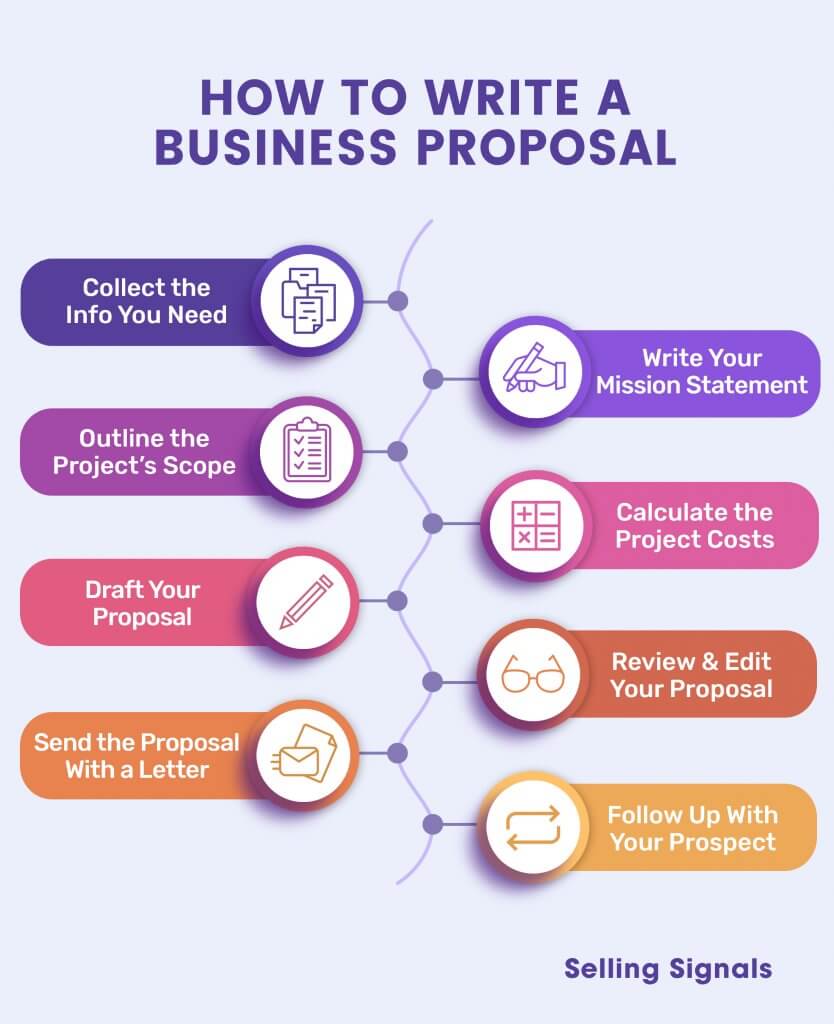
The first four steps help you identify the necessary data for your proposal. The next two represent the act of drafting your proposal based on the info you collected, and the last two help with sending and follow-up. Let’s now look at each step in depth so you know exactly how to create your own.
It’s best to personalize your business proposal to your prospect’s unique situation, needs, and pain points. When the proposal demonstrates to the prospect that you fully understand their needs, they’re more likely to approve it. But, to personalize it, you need to gather information about the prospect, like the problems they want solved, their budget, and their desired timeline.
You’ll accumulate much of this information throughout the sales process during lead generation, discovery, presenting, and any other impromptu conversations with the prospect. Typically, the bulk of it will come during a discovery call that takes place before you present your solution. On this discovery phone call, you’ll ask the prospect questions; you’ll then use their answers in your business proposal later on.
Some people use discovery call frameworks that act as checklists for the information they need to collect, and therefore the questions they need to ask. For example, the BANT framework prompts reps to ask about a prospect’s budget, authority to buy, needs, and timeline. Using a framework like BANT or CHAMP (challenges, authority, money, priority) adds structure to your discovery process. We talk about the different frameworks and who should use each in our discovery call article.
Now, here are the critical questions you need answered before creating a proposal:
As you ask your prospect these questions, write or type their answers. After the call, it’s best to transfer that information into a CRM system under the prospect’s account, where you can access it as you craft your proposal.
A proposal mission statement is a written paragraph to yourself that explains why you’re writing this business proposal in the first place. It’s covering the prospect’s problem, how you’re going to solve it, and what you’ll personally gain from it. The prospect will never see it, but it will act as your North Star. Whenever you’re stuck on what to write in your proposal, or simply demotivated, read your mission statement for direction and inspiration.
Here’s an example of a proposal mission statement:
The mission of this proposal is to show {Client Name} how they can solve the problem of generating too many unqualified leads that waste their sales team’s time. We will solve it using our lead scoring software, which will automatically assign points to leads, track their scores, and ensure that only leads above a certain score are passed to sales. This will increase {Client Name}’s close rate, job satisfaction amongst their salespeople, and revenue.
We’re perfectly equipped to do this because unlike our competitors, we use AI predictive analytics. If I close this deal, I’ll earn $X.
Writing a full business proposal can sometimes be a bit of a slog. Writer’s block comes in, and you might forget the “why” behind this endeavor. So you need those jolting reminders that you in fact are the perfect business to help this particular prospect, and that you’re close to getting a nice commission after closing the deal.
Your project’s scope refers to the work and deliverables required to satisfy your prospect’s needs and includes things like tasks, costs, timelines, and more. While your mission statement can be thought of as the why of the project, the project’s scope can be thought of as the who, what, when, where, and how of the project. Write this all out. Knowing the scope of the project will help you determine the price of your project as well as the time commitment on your end.
The outline of your project’s scope answers the following questions:
These answers will make up a lot of the content in your business proposal. So refer to this bulleted outline as you write. In the actual proposal, though, it won’t directly match this list. Some of the answers you’ve found like “where you’ll be working” or “what materials are needed” will help you determine a price. Others will be present in the proposal, typically falling under sections like timeline, deliverables, or terms and conditions.
For example, a business might use a projected timeline table to express when the main deliverables (e.g., SEO audit, physical product) will be received or the main milestones (e.g., first class, full access to SaaS solution) will be hit, as done in this table below from our free template. This helps the prospect visualize and understand the timeframe of the project, and allows them to assess whether it works for them.
Meanwhile, a terms and conditions section that deals with the legal aspects of the project is often used to outline exactly what you’ll provide the prospect, how you’ll be paid, and by when. This agreement, which should also be in the contract, ensures you don’t fall into scope creep — when your prospect asks you to do something out of the scope of agreed work. If during your relationship they ever ask for a task that feels out of scope, refer them to this document.
Now that you know the full scope of work (including any materials or labor), begin calculating the price you’ll charge the prospect. Businesses usually have their own methods of doing this. How you charge depends largely on the type of solution you offer. A freelance writer will have different pricing methods than a B2B seller. But, generally, you can break up the costs of your project into categories.
Here are some different costs to consider when pricing your project:
Typically, the category that’ll be the majority of your total cost is the labor hours (first bullet above) needed to complete the work. So, it’s important to get this estimate right. The last thing you want to do is underestimate how long a job will take and then end up losing money. To avoid this, multiply your first estimate by 1.5 to account for any mishaps or roadblocks that pop up during the project.
Lastly, if applicable, determine your fee and add it to the final price or bake it into the line item costs. The finished pricing should go into a pricing table in your business proposal like the one below from our template:
Now that you have all the required information, it’s time to write your first draft in either document or slideshow form. Typically, different businesses’ proposals will follow their own unique structures. However, all of them should clearly outline the main problem you’ll solve, how you’ll do it, and the pricing, timeline, and terms of the project.
Follow along in our free template as we go over the key sections of a business proposal, some of which you should be familiar with from the screenshots above. Here are some of the most important sections to include in your business proposal:
As for length, Proposify did an audit of over 260k sales proposals to find the answer. The average page count across all proposals was 13, while the average of all winning proposals was 11. This reveals that shorter sales proposals on average do better. This trend was true for the number of sections, as well (an average of eight, or seven for winners). Keep in mind that some sections take up more than one page.
How long your proposal is depends on the information your prospect needs to make their buying decision. More complex products and services generally require more words and sections to get key points across. But, as a rule, try to convey your information as concisely as possible. A shorter read means less room for the prospect to become overwhelmed or confused. In some cases, even a one-page proposal is best.
Check out our full article breaking down our business proposal template in even greater detail. We dive further into what the proposal sections in the list above — as well as others, like credentials and table of contents — should look like.
To make your business proposal as succinct, clear, and pleasurable to read as possible, you must go over it and check for any errors, problems with flow, or disorder. Make use of plugins like Grammarly that can automatically spell- and grammar-check your work. Also, check out Paul Graham’s advice on writing simply.
Here are some other things to do when editing your writing in your proposal:
A well-written proposal will also act as an expression of the future work you’ll provide for the prospect. If they see that you took the time to write a clear and professional proposal, they’ll expect that the product or service they’re considering buying will be of a similar quality.
Clarity is essential in a proposal. A smart buyer won’t spend money on something that confuses them. So, I would send my business proposal to a colleague and ask them to highlight or point out any sentences that confuse them even in the slightest.
Usually, you’ll send your finished business proposal as an email attachment to your main point of contact and decision maker. The body of the email on which it’s attached is known as a proposal letter. This letter summarizes the proposal and tells the prospect why they should open and accept it, like in the example below.
Here are the steps involved in writing a business proposal letter:
Sometimes, your prospect will have a formal proposal submission process that they outline in their request for proposal (RFP). If this is the case, follow the instructions exactly as stated. Some buyers will ask you to follow specific guidelines as a test of your attention to detail and diligence. If you’re unsure of who should be the recipient, ask your main point of contact.
To learn more about sending a letter with your proposal, check out our article on writing a business proposal letter. There, we explain the five steps to crafting an effective letter, plus we provide a free template and examples.
After the prospect receives your proposal, they might tell you how long they’ll take to discuss it internally. If this is the case, give them that time plus two more business days before you follow up on the proposal via email.
If they didn’t tell you when they’d have an answer, follow up after the third business day. This is so the proposal is still fresh on their minds. Reach out in a friendly and noninvasive manner. By no means rush them. Simply send them a short email asking if they had a chance to read the proposal and if they had any questions that you could answer for them. This will serve as a little reminder as well as a chance for them to pose questions they need to ask you before buying.
Here’s an example of a good follow-up email:
Depending on the proposed solution and your relationship with the prospect, your proposal can sometimes double as a contract or you can send a separate contract along with the proposal. In this case, your follow-up will involve encouraging them to sign. Consider using electronic signature software to make this easier for them and/or contract management software to see whether they've reviewed the contract so you can understand how and when to ping them again.
When you’re ready to start the closing process with a prospect, following these seven steps will ensure the business proposal you send is both efficient and effective. And now that you know what makes a business proposal great, we’ve also included examples below for you to get more inspiration when creating your own proposal.
Sometimes it helps to look at business proposal examples from which you can take ideas and tactics. You can also see how they use images and icons to get their points across, as well as the language they use. Below are four of the top business proposal examples for selling products or services.
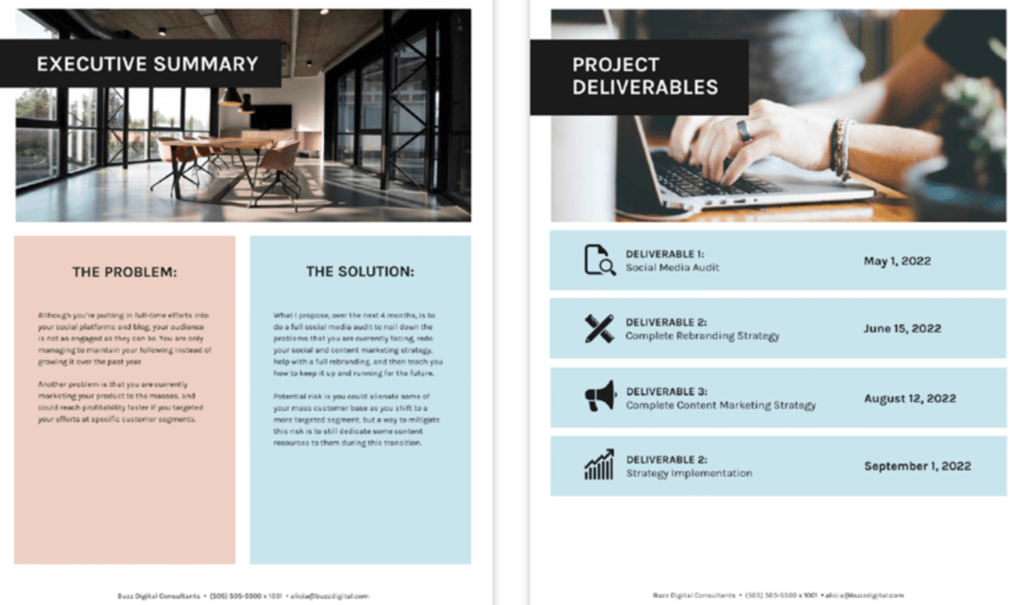
This B2C consulting proposal has a scannable layout and a tasteful cotton candy color scheme that looks both professional and pleasing.
It juxtaposes the problem statement right next to the solution statement, making it easy for the prospect to read about the solution while the problem is fresh in their mind. Since it’s a consulting example, it added a SWOT analysis box that lists the prospect’s weaknesses, opportunities, etc., thereby demonstrating expertise.
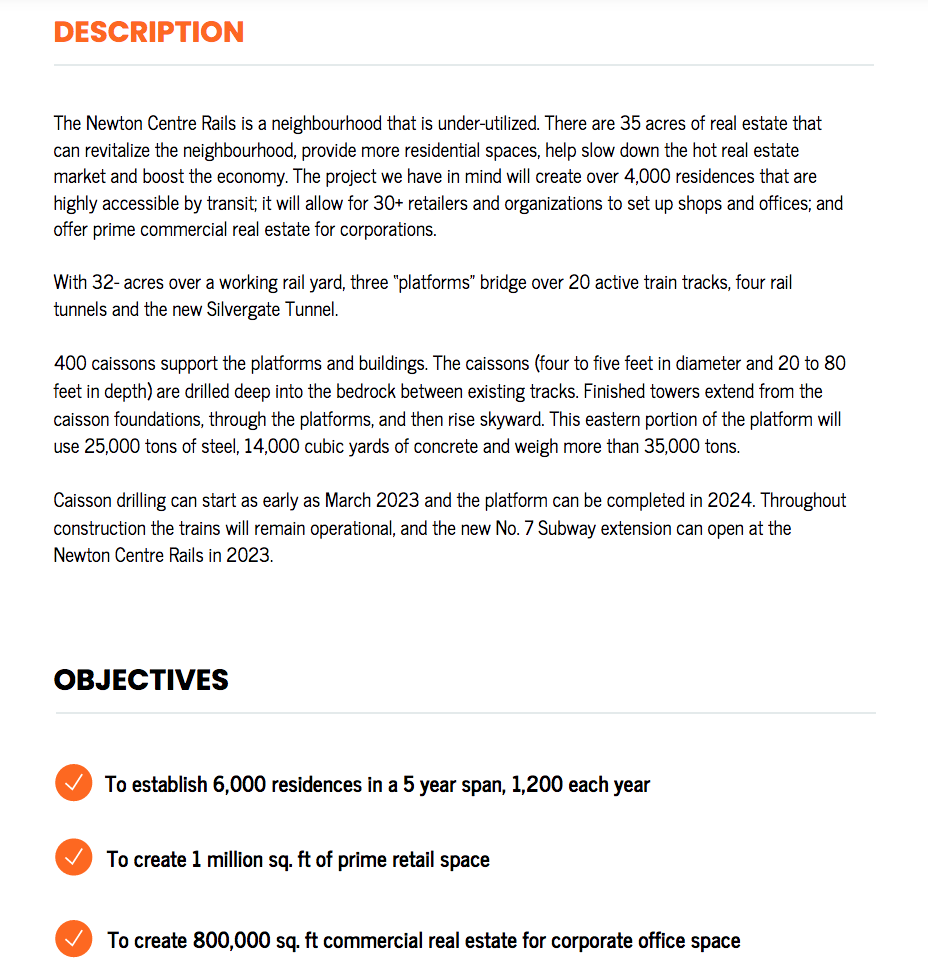
This development business proposal does a nice job of illustrating the scope of work using numbers, graphics, and written text — these will help your bid stand out.
It uses a pricing box that makes it easy to see the exact cost. Whenever you can make something clearer or easier to understand for the prospect, take the opportunity. The proposal also lays out its three objectives for the project at the beginning, which will get the reader excited to read on to learn how it’ll be accomplished.
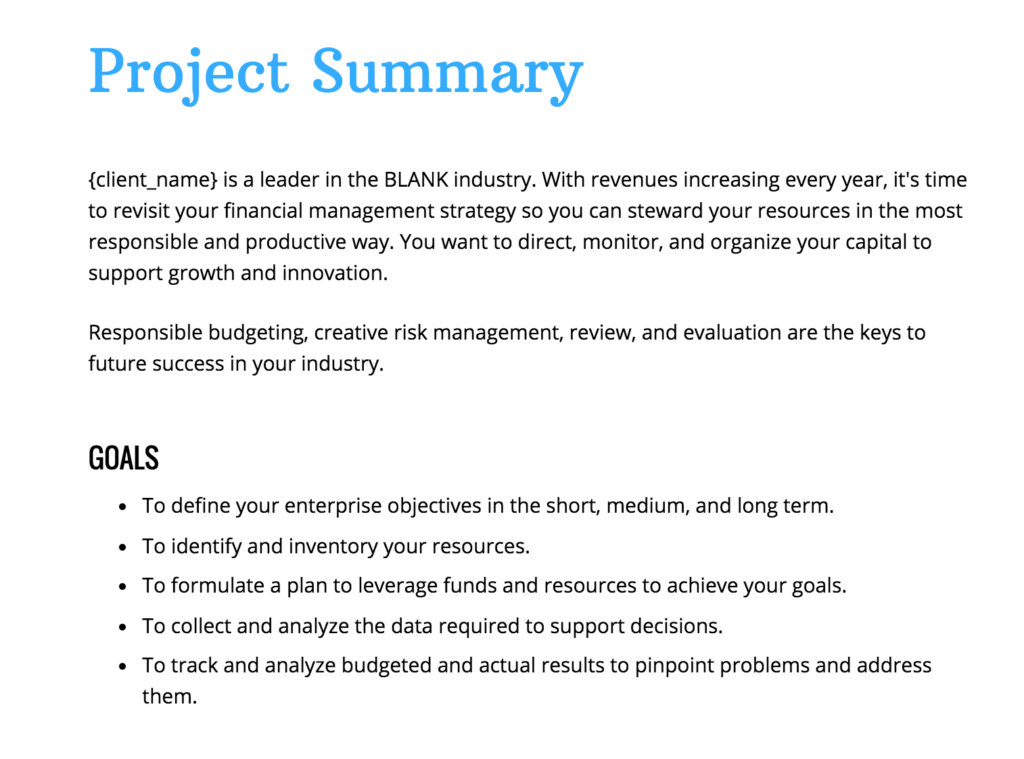
Proposify’s financial services business proposal includes an image at the top of almost every single page, making it visually appealing to the reader.
It also has a short and sweet project summary section (shown above), also known as the proposed solution section, where it uses bullet points to list out the goals they’ll achieve for their client. The proposal also dedicates a page to introducing the team members involved in the project.
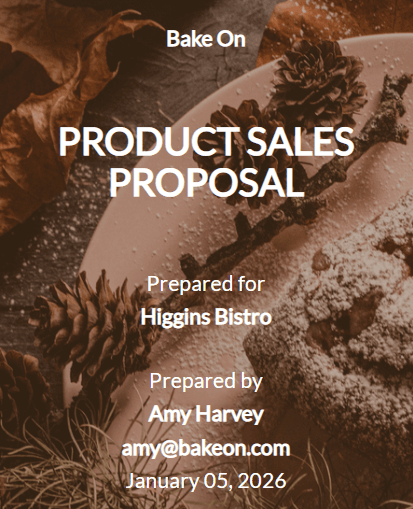
This product sales proposal example from Template.net offers a clear way to lay out the details of a product agreement.
The cover page lists both company names plus a clear title, and then the executive summary sums up the proposal, including the solution, duration, and cost. Next comes the scope of work and pricing details. Just before the deal terms, the proposal lists the team and their photos, then a few testimonials. While the proposal is brief, it states the key information in a clear, personalized way.
These are examples that also serve as templates, so when you download the one that fits best with your business, you can either replace the provided verbiage with your own details or simply reference the example as you create your proposal from scratch or using our template.
For inspiration, check out these four tips and ideas related to using a template, videos, images, and software as you craft your proposals. They’ll level up your business proposal regardless of your business type or industry.
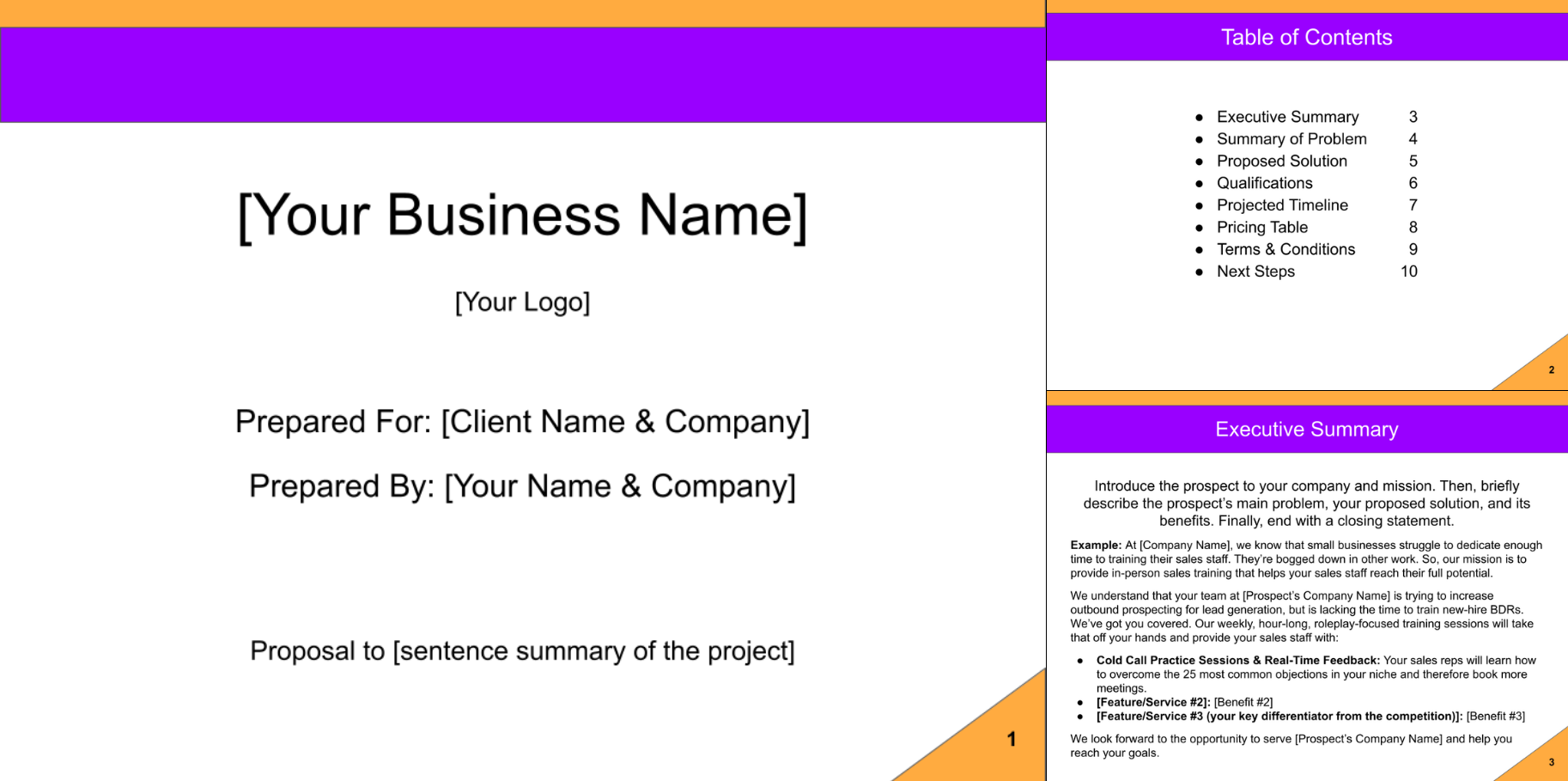
A template is a proposal that’s pre-designed and customizable, like the free one we provided in this article. There are a lot of them online that you can customize to your liking, changing their background, text, color scheme, and messaging to fit your brand. Find one, then edit it until it’s about 90% completed. Then, all you have to do is personalize that last 10% for each new prospect.
For example, you might just have to swap out the dollar amounts for each square in your pricing table whenever you have a new prospect. Or you might just switch out the keywords in the problem statement to fit the problem of this particular prospect. Having a template makes the whole proposal creation process more efficient.
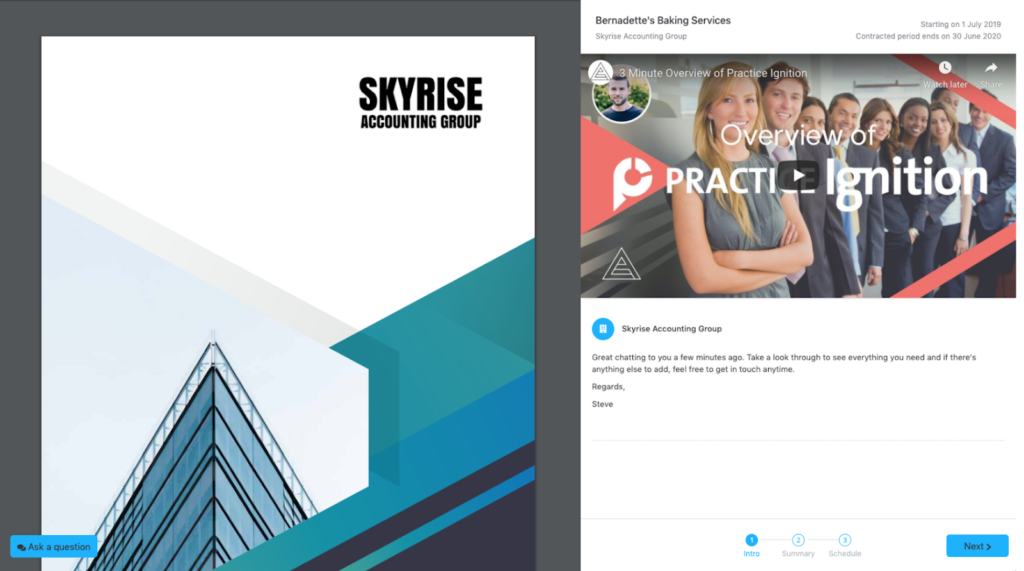
Consider including a video in your business proposal as a way to engage the prospect and enhance their experience. The video should be in the body of your proposal. Perhaps you can use it to show a video case study or to introduce your team, like in the proposal above. Not only is a video a nice break from reading, it’s also a great way for you to get your information across without adding too many words to the page.
Most proposal management software enable you to embed a video that exists on another webpage, like your website page or YouTube, into your electronic proposal. The same goes for PowerPoint or Google Slides. If you’re using a Word Document, follow these steps for embedding a video. Or you can link to a YouTube video in the text that’ll open in another tab for the reader.
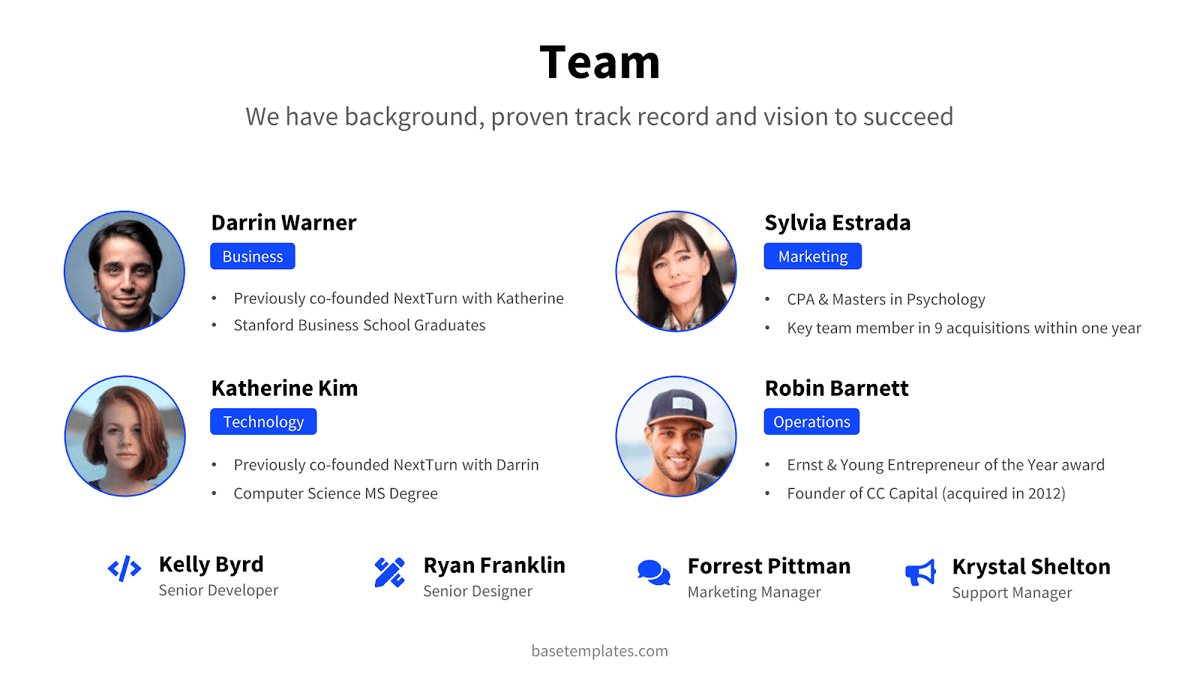
According to Proposify's study, including images in your proposals can increase your deal close rates by 26%. You can use them to stand out from the crowd, to introduce your team members, or to split up the text and make the design look more visually appealing and professional. Try using graphs or charts to illustrate any trends or stats you’re sharing.

Proposal management software are web-based tools that help you write, send, and manage business proposals. With these tools, you can use their templates and track proposal analytics (e.g., the close rate of one proposal vs. another). You can then test different proposal lengths, section usage, and writing techniques against each other and approach optimization over time.
Plus, these software platforms also typically offer electronic signatures on the proposals, which, according to Proposify’s study, can help deals close 60% faster and at a 4.6X higher rate. They also make it easier to create and track business proposals as you send them out to all your future customers.
These tips will save you time and energy, help you keep your proposals enticing and brief, and support you to track your success and make adjustments as needed. Keep these best practices in mind as you create your own business proposal, and you'll increase your success rates.
For a list of the best business proposal ideas to improve your own proposal, check out our roundup of top tips and ideas from expert sellers. There, you’ll learn key strategies and approaches for business proposal optimization.
Business proposals are often your final chance of the lead nurturing phase to explain how your solution adds value to your prospect. They also show the prospect what the business relationship will look like if they decide to sign the contract. Therefore, it’s crucial that you make this document as clear, convincing, and engaging as possible. So follow the eight steps above to get your proposal accepted and prepare to close the sale.


Sam is a former SaaS sales rep turned freelance writer. He spent his career selling real estate technology to C-suite executives before switching over to blogging, where he now covers sales, marketing, and small business topics. Sam specializes in lead generation, lead nurturing, and deal closing articles for Selling Signals. When he’s not researching the latest sales trends, he’s either penning short stories, hiking, or reading in NYC’s Washington Square Park.

Selling Signals delivers actionable advice for sales and marketing professionals. Learn strategies that help you hit targets, strengthen customer relationships, and win more business. Get expert advice on lead generation, sales processes, CRM software, sales management, and account management directly to your inbox.
Property of TechnologyAdvice. © 2026 TechnologyAdvice. All Rights Reserved
Advertiser Disclosure: Some of the products that appear on this site are from companies from which TechnologyAdvice receives compensation. This compensation may impact how and where products appear on this site including, for example, the order in which they appear. TechnologyAdvice does not include all companies or all types of products available in the marketplace.